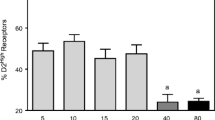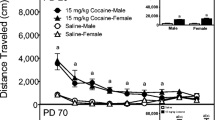Abstract
Rationale
Cocaine use during pregnancy is associated with alterations in the dopamine (DA) system in the fetal brain. However, little is known about the effects of prenatal cocaine exposure on the postnatal dopaminergic system.
Objectives
The objective of the study was to examine DA receptor function in adult monkeys that were prenatally exposed to cocaine.
Materials and methods
Male and female rhesus monkeys (∼13 years old) that had been prenatally exposed to cocaine (n = 10) and controls (n = 10) were used in all studies. First, DA D2-like receptor availability was assessed using positron emission tomography and the D2-like receptor radiotracer [18F]fluoroclebopride (FCP). Next, D3 receptor function was assessed by measuring quinpirole-induced yawning (0.03–0.3 mg/kg). Finally, D1-like receptor function was examined by measuring eye blinking elicited by the high-efficacy D1-like receptor agonist SKF81297 (0.3–3.0 mg/kg).
Results
There were no differences between groups or sexes in D2-like receptor availability in the caudate nucleus, putamen or amygdala. However, quinpirole elicited significantly more yawns in prenatally cocaine-exposed monkeys compared with control monkeys. A significant correlation between gestational dose of cocaine and peak effects of quinpirole was observed. In all monkeys, administration of SKF81297 elicited dose-dependent increases in eye blinks that did not differ between groups.
Conclusions
These findings suggest that prenatal cocaine exposure can have long-term effects on DA D3 receptor function in adults.




Similar content being viewed by others
References
Bayer LE, Brown A, Mactutus CF, Booze RM, Strupp BJ (2000) Prenatal cocaine exposure increases sensitivity to the attentional effects of the dopamine D1 agonist SKF81297. J Neurosci 20:8902–8908
Bettinardi V, Pagani E, Gilardi MC et al (1999) An automatic classification technique for attenuation correction in positron emission tomography. Eur J Nucl Med 26:447–458
Bhide PG (2009) Dopamine, cocaine, and the development of cerebral cortical cytoarchitecture: a review of current concepts. Semin Cell Dev Biol 20:395–402
Boulay D, Depoortere R, Perrault G, Borrelli E, Sanger DJ (1999a) Dopamine D2 receptor knock-out mice are insensitive to the hypolocomotor and hypothermic effects of dopamine D2/D3 receptor agonists. Neuropharmacology 38:1389–1396
Boulay D, Depoortere R, Rostene W, Perrault G, Sanger DJ (1999b) Dopamine D3 receptor agonists produce similar decreases in body temperature and locomotor activity in D3 knock-out and wild-type mice. Neuropharmacology 38:555–565
Chaperon F, Tricklebank MD, Unger L, Neijt HC (2003) Evidence for regulation of body temperature in rats by dopamine D2 receptor and possible influence of D1 but not D3 and D4 receptors. Neuropharmacology 44:1047–1053
Christian BT, Vandehey NT, Fox AS et al (2009) The distribution of D2/D3 receptor binding in the adolescent rhesus monkey using small animal PET imaging. Neuroimage 44:1334–1344
Code RA, Tang AH (1991) Yawning produced by dopamine agonists in rhesus monkeys. Eur J Pharmacol 201:235–238
Collins GT, Witkin JM, Newman AH et al (2005) Dopamine agonist-induced yawning in rats: a dopamine D3 receptor-mediated behavior. J Pharmacol Exp Ther 314:310–319
Collins GT, Newman AH, Grundt P et al (2007) Yawning and hypothermia in rats: effects of dopamine D3 and D2 agonists and antagonists. Psychopharmacology 193:159–170
Czoty PW, Morgan D, Shannon EA, Gage HD, Nader MA (2004) Characterization of dopamine D1 receptor function in socially housed cynomolgus monkeys. Psychopharmacology 174:381–388
Czoty PW, McCabe C, Nader MA (2005) Assessment of the reinforcing strength of cocaine in socially housed monkeys using a choice procedure. J Pharmacol Exp Ther 312:96–102
Czoty PW, Riddick NV, Gage HD (2009) Effect of menstrual cycle phase on dopamine D2 receptor availability in female cynomolgus monkeys. Neuropsychopharmacology 34:548–554
Dodd ML, Klos KJ, Bower JH, Geda YE, Josephs KA, Ahlskog JE (2005) Pathological gambling caused by drugs used to treat Parkinson disease. Arch Neurol 62:1377–1381
Fang Y, Janowsky A, Ronnekleiv OK (1997) Cocaine exposure in fetal rhesus monkey: consequences for dopamine D1- and D2-like receptor binding densities. Brain Res Dev Brain Res 104:163–174
Farde L, Hall H, Pauli S, Halldin C (1995) Variability in D2-dopamine receptor density and affinity: a PET study with [11C]reclopride in man. Synapse 20:200–208
Friedman E, Yadin E, Wang HY (1996) Effects of prenatal cocaine on dopamine receptor-G protein coupling in mesocortical regions of the rabbit brain. Neuroscience 70:739–747
Jones LB, Stanwood GD, Reinoso BS et al (2000) In utero cocaine-induced dysfunction of dopamine D1 receptor signaling and abnormal differentiation of cerebral cortical neurons. J Neurosci 20:4606–4614
Jutkiewicz EM, Bergman J (2004) Effects of dopamine D1 ligands on eye blinking in monkeys: efficacy, antagonism, and D1/D2 interactions. J Pharmacol Exp Ther 1999:649–661
Laakso A, Vilkman H, Bergman J et al (2002) Sex differences in striatal presynaptic dopamine synthesis capacity in healthy subjects. Soc Biol Psychiatry 52:759–763
Lidow MS (1998) Nonhuman primate model of the effect of prenatal cocaine exposure on cerebral cortical development. Ann NY Acad Sci 846:182–193
Logan J, Fowler JS, Volkow ND et al (1996) Distribution volume ratios without blood sampling from graphical analysis of PET data. J Cereb Blood Flow Metab 16:834–840
Mach RH, Luedtke RR, Unsworth CD et al (1993) 18F-labeled benzamides for studying the dopamine D2 receptor with positron emission tomography. J Med Chem 36:3707–3720
Mach RH, Nader MA, Ehrenkaufer RL et al (1996) Comparison of two fluorine-18 labeled benzamide derivatives that bind reversibly to dopamine D2 receptors: in vitro binding studies and positron emission tomography. Synapse 24:322–333
Martelle JL, Claytor R, Ross JT et al (2007) Effects of two novel D3-selective compounds, NGB 2904 and CJB 090, on the reinforcing and discriminative stimulus effects of cocaine in rhesus monkeys. J Pharmacol Exp Ther 321:573–582
Martinez D, Broft A, Foltin RW et al (2004) Cocaine dependence and D2 receptor availability in the functional subdivisions of the striatum: relationship with cocaine-seeking behavior. Neuropsychopharmacology 29:1190–1202
Moody CA, Frambes NA, Spear LP (1992) Psychopharmacological responsiveness to the dopamine agonist quinpirole in normal weanlings and in weanling offspring exposed gestationally to cocaine. Psychopharmacology 108:256–262
Moore RJ, Vinsant SL, Nader MA, Porrino LJ, Friedman DP (1998a) Effect of cocaine self-administration on striatal dopamine D1 receptors in rhesus monkeys. Synapse 28:1–9
Moore RJ, Vinsant SL, Nader MA et al (1998b) Effect of cocaine self-administration on dopamine D2 receptors in rhesus monkeys. Synapse 30:88–96
Morgan D, Grant KA, Gage HD et al (2002) Social dominance in monkeys: dopamine D2 receptors and cocaine self-administration. Nat Neurosci 5:169–174
Morris P, Binienda Z, Gillam MP et al (1996) The effect of chronic cocaine exposure during pregnancy on maternal and infant outcomes in the rhesus monkey. Neurotoxicol Teratol 18:147–154
Morris P, Binienda Z, Gillam MP et al (1997) The effect of chronic cocaine exposure throughout pregnancy on maternal and infant outcomes in the rhesus monkey. Neurotoxicol Teratol 19:47–57
Munro CA, McCaul ME, Wong DF et al (2006) Sex differences in striatal dopamine release in healthy adults. Biol Psychiatry 59:966–974
Nader MA, Grant KA, Gage HD et al (1999) PET imaging of dopamine D2 receptors with [18F]fluoroclebopride in monkeys: effects of isoflurane- and ketamine-induced anesthesia. Neuropsychopharmacology 21:35–46
Nader MA, Daunais JB, Moore T et al (2002) Effects of cocaine self-administration on striatal dopamine systems in rhesus monkeys: initial and chronic exposure. Neuropsychopharmacology 21:589–596
Nader MA, Morgan D, Gage HD et al (2006) PET imaging of dopamine D2 receptors during chronic cocaine self-administration in monkeys. Nat Neurosci 9:1050–1056
Nader MA, Czoty PW, Gould RW, Riddick NV (2008) PET imaging studies of dopamine receptors in primate models of addiction. Phil Trans Royal Soc B 363:3223–3232
Nair BS, Watson RR (1991) Cocaine and the pregnant woman. J Reprod Med 36:862–867
Paule MG, Gillam MP, Binienda Z, Morris P (1996) Chronic cocaine exposure throughout gestation in the rhesus monkey. Pregnancy outcomes and offspring behavior. Ann NY Acad Sci 801:301–309
Paule MG, Gillam MP, Allen RR, Chelonis JJ (2000) Effects of chronic in utero exposure to cocaine on behavioral adaptability in rhesus monkey offspring when examined in adulthood. Ann NY Acad Sci 914:412–417
Pohjalainen T, Rinne JO, Nagren K et al (1998) Sex differences in the striatal dopamine D2 receptor binding characteristics in vivo. Am J Psychiatry 155:768–773
Rogers JG, Harrop R, Kinahan PE (1987) The theory of three-dimensional image reconstruction for PET. IEEE Trans Med Imaging 6:239–243
Silk J, Short J, Roberts J, Kusnitz J (1993) Gestation length in rhesus macaques (Macaca mulatta). Intern J Primatol 14:95–104
Smith S (2002) Fast robust automated brain extraction. Hum Brain Map 17:143–155
Sokoloff P, Diaz J, Le Foll B, Guillin O, Leriche L, Bezard E, Gross C (2006) The dopamine D3 receptor: a therapeutic target for the treatment of neuropsychiatric disorders. CNS Neurol Disord Drug Targets 5:25–43
Staley JK, Mash DC (1996) Adaptive increase in D3 dopamine receptors in the brain reward circuits of human cocaine fatalities. J Neurosci 16:6100–6106
Stanwood GD, Levitt P (2007) Prenatal exposure to cocaine produces unique developmental and long-term adaptive changes in dopamine D1 receptor activity and subcellular distribution. J Neurosci 27:152–157
United States Department of Health and Human Services, Substance Abuse and Mental Health Services Administration SAMHSA Office of Applied Studies (1996) Results from the 1992 National Pregnancy and Health Survey. A report
Unterwald EM, Ivkovic CM et al (2003) Prenatal exposure to cocaine decreases adenylyl cyclase activity in embryonic mouse striatum. Brain Res Dev Brain Res 147:67–75
Volkow D, Wang GJ, Fowler JS et al (1999) Reinforcing effects of psychostimulants in humans are associated with increases in brain dopamine and occupancy of D(2) receptors. J Pharmacol Exp Ther 291:409–415
Wang HY, Runyan S, Yadin E, Friedman E (1995) Prenatal exposure to cocaine selectively reduces D1 dopamine receptor-mediated activation of striatal Gs proteins. J Pharmacol Exp Ther 273:492–498
Woods RP, Mazziotta JC, Cherry SR (1993) MRI-PET registration with automated algorithm. J Comput Assist Tomogr 17:536–546
Acknowledgements
This research was supported by National Institute on Drug Abuse grants R01 DA25120, R37 DA10584 and K31 DA024485. The authors report no conflict of interest and would like to acknowledge the technical assistance of Tonya Calhoun, Kimberly Black, Holly Smith, and Whitney Wilson. The authors also thank Dr. Merle Paule for providing information related to the histories of these monkeys and Dr. Anthony Liguori for statistical consultation.
Author information
Authors and Affiliations
Corresponding author
Rights and permissions
About this article
Cite this article
Hamilton, L.R., Czoty, P.W., Gage, H.D. et al. Characterization of the dopamine receptor system in adult rhesus monkeys exposed to cocaine throughout gestation. Psychopharmacology 210, 481–488 (2010). https://doi.org/10.1007/s00213-010-1847-2
Received:
Accepted:
Published:
Issue Date:
DOI: https://doi.org/10.1007/s00213-010-1847-2




